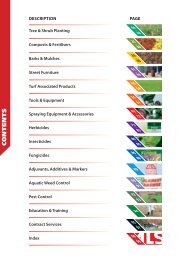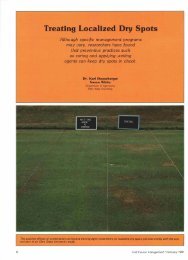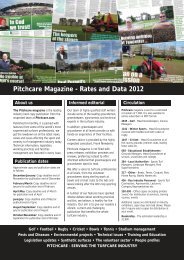Earning his Spurs - Pitchcare
Earning his Spurs - Pitchcare
Earning his Spurs - Pitchcare
You also want an ePaper? Increase the reach of your titles
YUMPU automatically turns print PDFs into web optimized ePapers that Google loves.
The Drain Brain!<br />
Sustainable drainage for golf courses and sports<br />
grounds - an environmental approach.<br />
By Jonathan Tucker, STRI Golf Course Architect<br />
and Head of Golf Development Services<br />
Quite simply, sustainable drainage<br />
systems aim to mimic, as closely<br />
as possible, the natural drainage<br />
of a site, in order to manage the impact<br />
of development in terms of flood risk<br />
and water pollution.<br />
Why do we need it?<br />
‘Sustainability’ is the latest buzzword,<br />
enthused by environmentalists. But, to<br />
many, its meaning is somewhat fuzzy.<br />
What relevance has sustainability to the<br />
drainage of a waterlogged pitch or golf<br />
course, where the primary aim is to<br />
remove water as rapidly as possible with<br />
minimum cost and disturbance? First,<br />
we need to consider the background to<br />
the development of sustainable drainage<br />
and the ‘drivers’ for change.<br />
There is increasing evidence that the<br />
earth’s climate is changing, with wetter<br />
and milder winters (associated with<br />
more intensive rainfall events), and<br />
hotter, drier summers. The impact of<br />
these changes include:<br />
• Increased run-off and risk of flooding<br />
• Greater erosion and entrapment of<br />
sediment in surface run-off which,<br />
potentially, can cause harm to aquatic<br />
species<br />
• Increase in pollutants from<br />
contaminated floodwater<br />
• Reduced availability of water for<br />
irrigation<br />
• Reduced groundwater recharge -<br />
which has a knock-on effect on water<br />
supplies and aquatic eco-systems,<br />
which are dependent on groundwater<br />
The government has also set out<br />
priorities for sustainable management of<br />
water in the future which include:<br />
• Prudent use of water resources in<br />
keeping water use within the limits of<br />
its replenishment<br />
• Tackling diffuse pollution of water<br />
• Minimising the creation of new flood<br />
risks and effectively managing<br />
existing flood risks<br />
Drainage of a new or, indeed, existing<br />
site may include a number of<br />
stakeholders, including Local<br />
Authorities, environmental regulators<br />
(notably the Environment Agency),<br />
Highways Authorities, private<br />
landowners/land managers and, possibly,<br />
internal drainage boards. Therefore,<br />
compliance with the relevant<br />
environmental legislation and<br />
observance of planning policy guidance<br />
are vital considerations when planning<br />
new drainage systems as, potentially,<br />
they could have a significant impact on<br />
the environment.<br />
Effective drainage solutions for sports<br />
grounds and golf courses are essential to<br />
both utilisation and playing surface<br />
quality. Rapid removal of surface water<br />
is fundamental to the success of these<br />
systems. But, on the flip side, t<strong>his</strong> leads<br />
to a sharper spike in the rate of<br />
discharge and, if there is reduced<br />
infiltration, there may also be an<br />
increase in the volume of water reaching<br />
the final outfall.<br />
Changes to legislation and the<br />
regulatory framework will make a<br />
sustainable drainage approach essential<br />
into surrounding ground. T<strong>his</strong> effect is<br />
more pronounced where hard surfaces<br />
(roads/buildings) replace naturally free<br />
draining ground, but sports ground<br />
drainage can still have a significant<br />
effect when pre and post development<br />
conditions are compared (refer to<br />
Diagram 1).<br />
In order to restore the status quo, a<br />
‘brake’ may need to be placed on flow<br />
rates. T<strong>his</strong> process is known as<br />
attenuation and can be achieved through<br />
the temporary storage of water in, for<br />
example, hollows or ponds, from which<br />
water can be discharged at a controlled<br />
rate.<br />
To restore groundwater to predevelopment<br />
levels, some form of<br />
infiltration may also be needed, for<br />
example soakaways, depending on<br />
existing ground conditions.<br />
Finally, drainage water can,<br />
potentially, be a carrier of pollutants<br />
such as pesticides and fertiliser.<br />
Therefore, to maintain good water<br />
quality, some method of mopping up<br />
potential contaminates is a sensible<br />
approach, and t<strong>his</strong> could involve welldesigned<br />
reed beds. However,<br />
prevention is always better than cure!<br />
The Management Train<br />
The concept of the<br />
Management<br />
Train (no

















